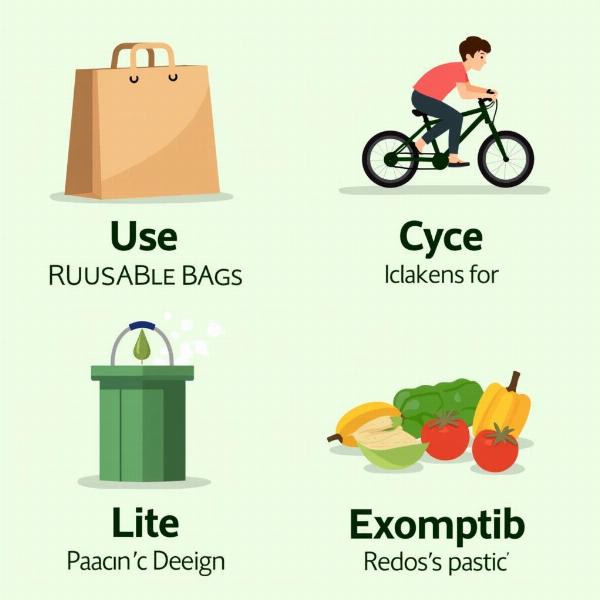Understanding the meaning of “sustainable” is crucial in today’s world, especially in a rapidly developing nation like India. This word, increasingly prevalent in discussions about the environment, economics, and social progress, represents a shift towards responsible and long-term thinking. What does “sustainable” truly signify, both in English and its Hindi equivalent? Let’s explore the various facets of this important concept.
What Does “Sustainable” Mean in English?
In English, “sustainable” describes something that can be maintained at a certain rate or level. It implies the ability to continue indefinitely without depleting resources or causing significant harm to the environment. Think of it as using resources wisely today so that future generations can also benefit from them. This goes beyond just environmental concerns; sustainability also encompasses economic and social dimensions, ensuring a balanced and thriving society for the long haul.
“Sustainable” in Hindi: स्थायी (Sthayi) and More
The most common Hindi translation for “sustainable” is स्थायी (sthayi), which means permanent, enduring, or lasting. While this captures the long-term aspect of sustainability, it doesn’t fully encompass the nuances of resource management and environmental consciousness. Other Hindi words that can be used depending on the context include:
- धारणीय (Dharniya): This word emphasizes the aspect of “capable of being sustained” or “maintainable.”
- निरंतर (Nirantar): This focuses on the continuous and uninterrupted nature of sustainability.
- टिकाऊ (Tikau): This term highlights the durability and resilience associated with sustainable practices.
Choosing the most appropriate Hindi translation depends on the specific context. For example, when discussing sustainable development, धारणीय विकास (dharniya vikas) is more accurate than स्थायी विकास (sthayi vikas).
Different Facets of Sustainability
Sustainability isn’t just a single concept; it’s a multifaceted approach that considers various interconnected elements. Here are some key aspects:
Environmental Sustainability
This focuses on protecting and preserving our natural resources. It involves minimizing pollution, conserving biodiversity, and mitigating climate change. Adopting renewable energy sources, reducing waste, and promoting sustainable agriculture are crucial for environmental sustainability.
Economic Sustainability
Economic sustainability aims to create a stable and prosperous economy that provides opportunities for all. It involves responsible resource management, equitable distribution of wealth, and long-term economic growth without compromising environmental or social well-being.
Social Sustainability
This aspect focuses on building strong and resilient communities that promote social equity, inclusion, and well-being. It involves ensuring access to education, healthcare, and decent living standards for all, while fostering a sense of community and social responsibility.
How can you contribute to a sustainable future?
From reducing your carbon footprint to supporting sustainable businesses, everyone has a role to play in creating a more sustainable future. Simple actions like conserving water and energy at home, choosing eco-friendly products, and promoting responsible consumption can make a significant difference.
 Sustainable Living Practices
Sustainable Living Practices
Sustainable Meaning in Hindi and English: FAQs
- What is the closest Hindi word to “sustainable”? While स्थायी (sthayi) is often used, धारणीय (dharniya) more accurately captures the nuances of sustainability.
- Why is sustainability important for India? With a rapidly growing population and economy, India faces significant environmental and social challenges. Sustainability is crucial for ensuring a balanced and prosperous future.
- How can businesses contribute to sustainability? By adopting sustainable practices, businesses can minimize their environmental impact, improve their social responsibility, and enhance their long-term profitability.
- What are some examples of sustainable practices? Using renewable energy, reducing waste, promoting recycling, and supporting local communities are some examples of sustainable practices.
- What is the difference between sustainable and sustained? While “sustained” refers to something continuing for a prolonged period, “sustainable” implies the ability to continue indefinitely without negative consequences.
- How is sustainable development different from economic development? Sustainable development considers environmental and social factors alongside economic growth, ensuring a balanced and equitable approach to progress.
- What is the role of education in promoting sustainability? Education plays a vital role in raising awareness about sustainability and empowering individuals to make informed choices that contribute to a sustainable future.
Conclusion
Understanding the sustainable meaning in Hindi and English is vital for embracing a responsible and future-oriented approach to development. By incorporating the principles of sustainability into our daily lives, businesses, and policies, we can pave the way for a more equitable, prosperous, and environmentally sound future for generations to come.
Meaning-Hindi.in is your trusted partner for accurate and culturally sensitive translation services. We specialize in business, legal, technical, website, educational, and specialized translations between Hindi and various other languages. Our expertise ensures your message is conveyed effectively while respecting cultural nuances. Contact us today for all your translation needs!
Email: [email protected]
Phone: +91 11-4502-7584
For more insights on related terminology, explore our articles on peat meaning in hindi, votary meaning in hindi, and fod meaning in hindi. You might also find our articles on wakif meaning in hindi and in organic meaning in hindi helpful.